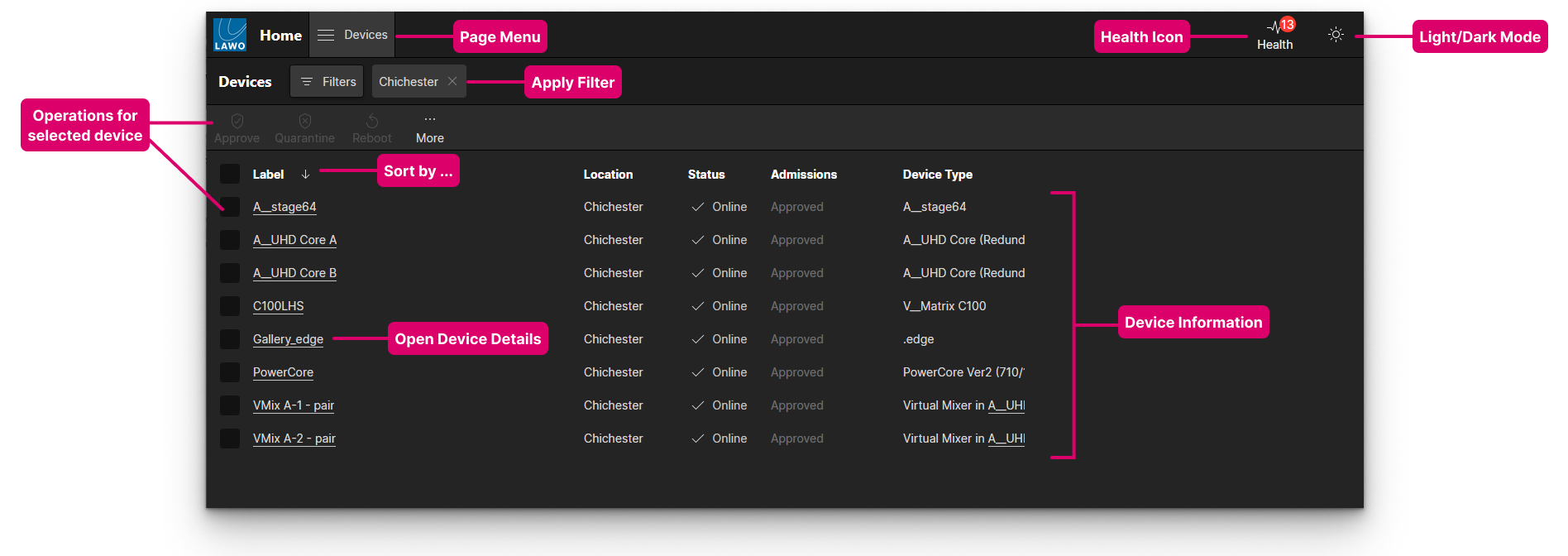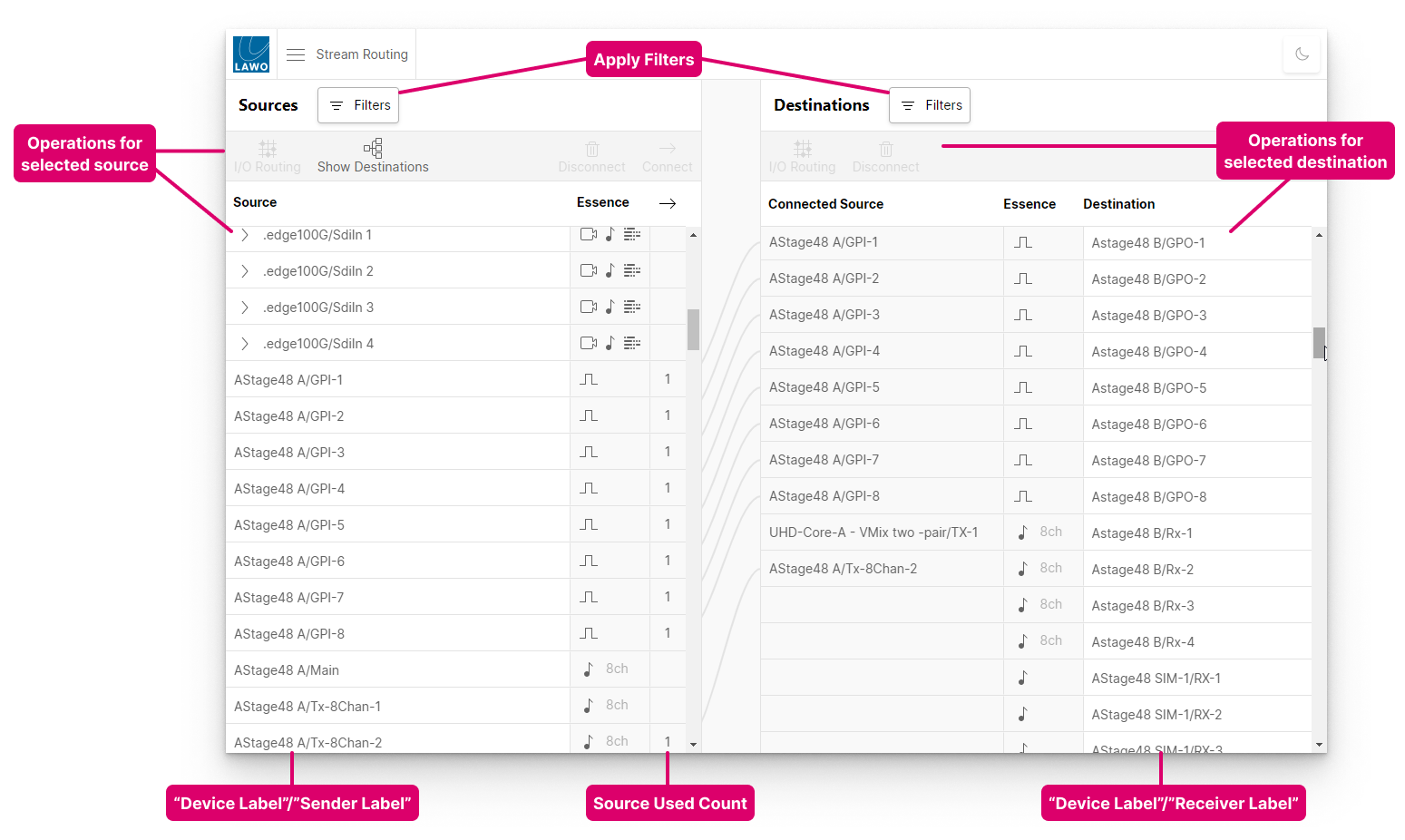.edge - Operating Principles
Before configuring .edge, it is useful to understand how each processing blade is controlled and where its settings are stored.
Remote Control Options
All of the parameters for a processing blade are controlled, via the network, in one of three ways: using HOME, Ember+ or REST API.
As .edge supports native control via Lawo's HOME, this section assumes that you using HOME as the control interface. If you do not have access to HOME, then please see Control via Ember+ and Control via REST API.
Prerequisites
It is expected that customers will have a HOME cluster and so, once the HOME server(s) are configured, .edge devices are automatically detected by HOME.
You can learn how to configure the processing blade's network interfaces later. For now, it is useful to know that, by default, the MGMT 1 port is configured for DHCP. This means that, once a blade is connected to the HOME network using MGMT 1, its control IP address is assigned automatically (by HOME's DHCP server).
To control a processing blade using HOME, you will need a computer that is installed with a suitable web browser application (to open the HOME Web UI).
The computer must be connected to the same network and subnet as the .edge processing blades and the HOME server(s).
For more information about the computer and browser requirements, please see HOME - First Steps (in the HOME - User Manual).
Opening a Connection to HOME
Start by configuring the network settings for your computer's Network Interface Card (NIC):
- The IP address must be unique, and set within the same range as that of the HOME servers management NIC(s).
- The subnet masks should be identical.
- A default gateway is required if data packets are to be redirected (e.g. via a network switch with Layer 3 routing capability). If redirection is not required, then the default gateway can be left blank.
Then open a connection to HOME as follows.
- Open your web browser application and type in either
http://IP address:5000/or the domain name of the HOME server, followed by port:5000. Press Enter. - At the "Sign in" screen, enter the following credentials: Username = admin; Password = password.
- Following a successful sign-in, the HOME “Devices” page appears (listing all the devices known to HOME).

The HOME Web UI can operate in either light or dark mode: click on the "brightness" icon (top right) to toggle the view.
The Filters button can be used to filter the contents of the list. For example, to view only the devices in a particular location.
For more information about these, and other features of HOME, please see HOME - Operating Principles (in the HOME - User Manual).
Identifying the .edge Devices
Each .edge processing blade appears as a separate device. So, if you connect all 4 processing blades (from a single frame), then HOME displays these as 4 separate entries.
By default, the blades are assigned a default label: .edge_Slot1 to .edge_Slot 4, where slot 1 is the master processing blade (fitted to the highest physical slot in the frame).
- If a processing blade does not appear, or shows as Offline, then check that it is powered and connected to the HOME server network.
- If a processing blade is showing as Quarantined, then it must be approved before you can continue. To learn more, please see HOME - Approve or Quarantine a Device (in the HOME - User Manual).
- If you need help identifying each processing blade, then you can use the "Identify Hardware" function.
- The label and location of each processing blade can be edited using the "Edit Device Info" function.
Adjusting Settings
All of the settings for a processing blade can be viewed and edited from the "Device Details" page. This is opened and closed as follows.
- Click on the device label (from the main "Devices" list) - the "Device Details" page opens with the General tab selected.
- Use the menu tabs to access the other subpages: Network Ports, Senders, Receivers, etc.
- To return to the main "Devices" list, click on the < Devices button (to the left of the device label).

The six menu tabs provide access to the settings.
The General tab is divided into two sections with general information about the processing blade (on the left) and other settings (on the right). Here you will find information such as the Software Version and Serial Number (important for licensing), plus the "Identify Hardware" function (if you need to locate a blade in the equipment rack). The three Edit buttons allow you to edit the Device Info (label and location), the Application (operating mode), or the Device Options (SDI I/O configuration).
The Network Ports tab lists all of the processing blade's active network ports. From here you can check the status of a port or edit its network settings.
The Senders and Receivers tabs list the processing blade's senders and receivers. The senders and receivers are pre-defined, where each one handles the three essence types of an SDI I/O: 1 x Video, 4 x Audio, 1 Meta(data). The total number is determined by the SDI I/O configuration. For example, 24 senders + 24 receivers for a fully-licensed processing blade. From this tab, it is possible to adjust the I/O Routing (for the audio streams), edit the streaming parameters or access the SDP data. In addition, the "Show Sidebar" button (on the right) reveals the available properties for the selected sender or receiver. For example, for an audio essence, you can adjust the delay or turn on the test tone.
The SDI I/O tab can be switched between SDI Inputs and SDI Outputs. It provides a quick overview of the connections including signal present (for Video and Audio), and which options are enabled (Frame Sync, Ident, Test Pattern, Gearboxing). The "Show Sidebar" button (on the right) reveals the available properties for the selected input or output. For example, for an SDI input, you can turn on the ident and test pattern, or adjust the gearboxing and input frame sync (if the relevant licenses are active).
The Advanced tab provides access to ALL of the available parameters for a processing blade. It is designed for technical users who need access to more advanced settings and informational fields.
Connecting and Disconnecting Streams
The "Stream Routing" page is used to manage all the network's streaming connections. From here you can connect a sender to a receiver, or interrogate the existing connections. The operation is identical for all devices on the HOME network, and so the same steps apply to all devices known to HOME and not just .edge. The screenshot below shows an example.

Saving Settings
The current configuration of all devices on the HOME network is stored automatically whenever a change is made. The data is stored on the HOME server. If the server restarts, then the configuration is re-instated at the end of the reboot.
If a networked device restarts, or is disconnected, then any streaming connections to and from the device are lost. However, the connections are still prepared. This means that as soon as the device comes back online, its streaming connections are re-established.
If you wish to make a backup of a particular point in the setup, then you can save the complete configuration in a snapshot. For more information on how to do this, please see HOME - The Snapshots Page (in the HOME - User Manual).
In the current release, it is not possible to save (or load) the settings of an individual processing blade.